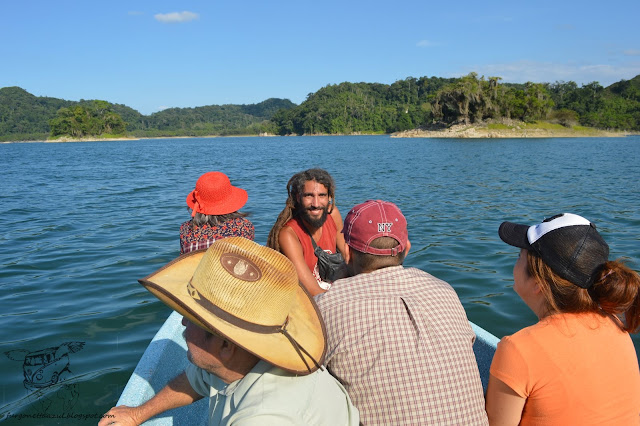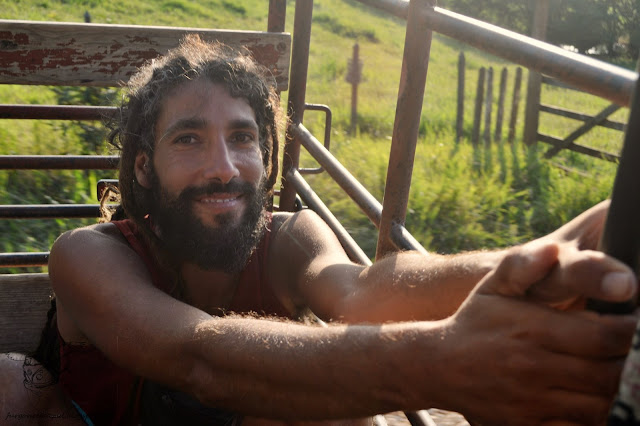Siempre había soñado con adentrarme en una de las arterias de Chiapas, la selva Lacandona.
Y al fin este viaje me dio la oportunidad de poder realizar uno de esos sueños que siempre parecieron lejanos, adentrarnos en la Selva Lacandona.
Durante tres días nos sumergimos en la inmensidad del la selva, mientras buscábamos poblados y naturaleza.
Lo primero que hicimos fue llegar hasta Nahá, un poblado maya( mayas que emigraron de la península del Yucatán en antiguas migraciones) donde acampamos en un lugar de ecoturismos. Aquí disfrutamos de adentrarnos en la selva o de la tranquilidad de una laguna. Además mostramos curiosidad por como vivían los pobladores de la zona, mayas que parecieran haber detenido el tiempo, pues se dedican normalmente a la vida agrícola y siguen ataviados con largas y blancas túnicas, conservando su largo cabello y quizás la tranquilidad de tiempos pasados.
Entonces decidimos salir de allí y aventurarnos a descubrir nuevos lugares. Nos decidimos por hacer autostop o tomar el primer colectivo que fuera a cualquier lugar. Entonces apareció una furgoneta llena de gente alegre, un grupo de amigos que nos invitó a subir y en consecuencia a pasar los próximos dos días con ellos, recorriendo poblados, cascadas y lagunas en la selva.
Fue un regalo haber encontrado aquel grupo de personas que nos invitaron a viajar con ellos, a compartir comida y a compartir experiencias.
Fueron dos días llenos de risas, anécdotas, buenos momentos y fraternidad junto a Lupita, Maldy, Cuqui, Flor, Esperanza , su marido y su padre( el incansable chófer de aquellas aventuras). Siempre recordaré la selva Lacandona por los momentos compartidos con este grupo de amigos y por la ayuda que nos mostraron, permitiéndonos llegar a lugares que por nuestra cuenta nunca habríamos alcanzado y creando nuevos recuerdos para siempre.
The next adventure was really off the beaten track. We visited the Lacandon jungle starting with a little and quiet ecotouristic hotel at Naha Lake where the very traditional Lacandon Mayas still wear traditional white clothes and long hair and make their own justice at small assemblies and practice some of the old religious rites, long fortgotten anywhere else.
The lake is surrounded by a beautiful forest, the colibris fly around the lake hiding in the flowers and the nights get lithen up by thousands of winged beetles (lightning bugs).
Next we decided to do some hitchhiking in the middle of the jungle, as the local transport was only available only twice a day (if you´re lucky;))
The car that picked us up was owned by a sweet mexican family and a group of their friends.They were just travelling around the region trying to get to know some new places, without an exact plan. We ended up spending two days with them!
We found our way to Laguna Guinea, the road leading there was opened only three months before our visit. Before only a few locals went there for hunting trips. The lake is placed on an ancient mayan place. The mayas are said to have submersed their city in order to hide it from the greedy spanish conquestors. Most of the villagers at the entrance to the jungle of Guinea Lake still have some figures and other mayan items, thet they found either in the water or in the forest. The oldest locals told us stories about gringos (which could be Americans or any other occidental nationality), who in the 50´ entered the jungle, dived in the water and took some pictures and then one night arrived with an helicopter and took away everything they have found under water....
The place is absolutely beautiful!Magical and we really felt that it was completely virgin and untouched.
Poczulismy zew dzungli i zapuscilismy sie daleko poza ubity szlak, prosto w dzungle Lacandona. Zaczelismy od jeziora Naha, gdzie lokalna ludnosc nadal kultywuje niektore przedchrzescijanskie zwyczaje, nosi tradycyjne stroje- w tym mezczyzni ubieraja sie w dlugie biale koszule i nosza dlugie wlosy. Wioski rzadzone sa przez zgrupowania starszyzny a nieluczni juz najstarsi nadal mowia w jezyku Lacandona.
Poniewaz o transport publiczny tu trudno (jeden autobus wczesnie rano, drugi pozno w nocy- kursuja jesli kursuja... ale przeciez nigdy nic nie wiadomo:)), logicznym wyborem byl autostop.... okazalo sie ze o stopa nie jest latwo w srodku dzungli.... Kiedy jednak w koncu doczekalismy sie przejezdzajacego samochodu, mielismy szczescie, bo nalezal do meksykanskiej rodziny, ktora zrobila wlasnie wycieczke krajoznawcza dla swoich znajomych. W rezultacie spedzilismy z nimi dwa dni;)
Naszym najwspanialszym odkryciem bylo jezioro Guinea ukryte dotychczas gleboko w dzungli. Droga do jeziora otwarta zostala zaledwie trzy miesiace przed naszym przybyciem, bylismy wiec jednymi z pierwszych osob, ktore odwiedzily to miejsce! Jezioro zwaqne jest takze jeziorem siedmiu wysp- wyspy te to podobno wierzcholki gor, jedyna pozostalosc po znajdujacym sie tu kiedys miescie Majow. Podobno zatopili oni swe miejsce zamieszkania w obawie przed chciwoscia hiszpanskich konkwistadorow. Rzeczywiscie- gdzieniegdzie na tych malych wysepkach znalezc mozna pozostalosci po budynkach (czyli kupki glazow porosniete mcham i drzewami) a pomiedzy nimi oszczepy i kawalki glinianych naczyn. W domach mieszkancow okolicznych wiosek (nowoczesne osadnictwo datuje sie tu na lata 50-te 20w., kiedy hodowano tu drzewa na gume) obejrzec znalezione przez nich figurki i roznorakie inne przedmioty uzytkowe znalezione zarowno w dzungli, jak i pod woda.
Podobno, w okolicach lat 50-tych, przyjezdzali to gringo (czyli Amerykanie, lub inni ludzie ¨z zachodu¨), ktorzy nurkujac wydobywali cos spod wody. Pokazywali nawet mieszkancom podwodne zdjecia kapliczek i budynkow. Ktorejs nocy przylecialy helikoptery i zabraly zarowno gringos, jak i wszystko to, co udalo im sie wydobyc...


































No hay comentarios:
Publicar un comentario